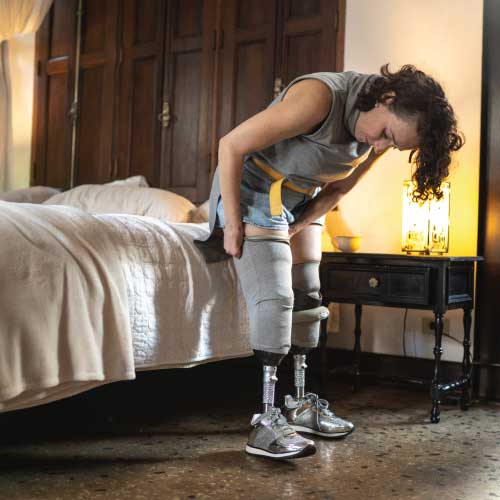How Augmented Visual Feedback Influences Balance Control
Previous studies have shown that people with lower-limb loss rely more on visual feedback to maintain balance than able-bodied individuals. Altering this mode typically disrupts postural control. But what happens when lower-limb amputees, particularly those with above-knee limb loss, are presented with augmented visual information during balance tasks? Researchers sought to find out.

In collaboration with Germany-based Pfänder Orthopedics, researchers investigated how unilateral above-knee amputees use visual feedback to maintain balance while standing.
The study
The researchers tapped two groups: Ten unilateral above-knee amputees and ten able-bodied participants (the control group). The participants' ages were considerably older (54,70 ± 13,84 years) than those in similar studies.
The participants stood on a pressure platform in front of a monitor located 1.50 m away to determine how augmented visual feedback affects postural balance. The monitor showed a square white field and a light blue concentric ring around a target circle at eye level.
Then the pressure platform was displayed within the white field as a dark blue movable dot. The participant's task was to keep the dark blue circle within the target circle. This measures the real-time center of pressure.
A shift in the participant's center of pressure is an indirect measure of postural sway, which measures an individual's ability to maintain balance.
Results
The researchers found that getting real-time visual feedback of the position of the center of pressure did not reduce the sway area of both groups. The amputee participants found it more challenging to maintain balance when the visual feedback was augmented (delayed or magnified). This led to a larger sway area than in the control group.
During the tasks, the researchers noticed differences in the limb dynamics when participants adjusted their balance to respond to various visual feedback. The amputee participants displayed lower dynamics in the residual limb than in the intact leg. And when compared to the dynamics of both dominant and non-dominant legs of the control group, the dynamics of the residual limb were still significantly lower. Because of this, the researchers noted that the residual limb's somatosensory contributions couldn't compensate for the lack of sensory feedback from the missing foot and knee.
Furthermore, the amputee group's intact legs showed higher dynamics than the dominant legs of the control group. Because of this, the intact leg was able to compensate for the residual limb's lower dynamics yet failed to reduce the sway area.
The bottom line
The findings of this study can go a long way toward improving the design of prosthetic limbs. Building on the results of this study, the researchers recommended that future studies focus on restoring sensory feedback through intra-neural or surface electrical stimulation, which may improve how amputees perform in balance tasks.
However, it's going to take years before the public can get access to better prosthetic limbs. If you or someone you know is currently struggling with balance, we suggest consulting your prosthetist and physical therapist. We also recommend performing balance-improving exercises at home and ensuring that your prosthetic socket fits well and your alignment is optimized.










































































